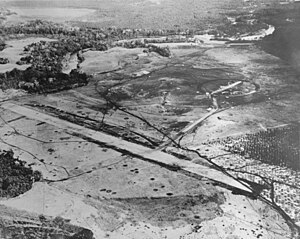Henderson Field (Guadalcanal)
| Henderson Field | |
|---|---|
| Part of the Pacific Theater of World War II | |
| Guadalcanal, Solomon Islands | |

Henderson Field in late August 1942, shortly after Allies began operations there
|
|
| Coordinates | 09°25′40.8″S 160°03′17.24″E / 9.428000°S 160.0547889°E |
| Site history | |
| Built | 1942 |
| Built by | Japanese Empire ( Finished by United States ) |
Henderson Field is a former military airfield on Guadalcanal, Solomon Islands during World War II. Originally built by the Japanese, the conflict over its possession was one of the great battles of the Pacific war. Today it is Honiara International Airport.
After the occupation of the Solomon Islands in April 1942, the Japanese military planned to capture Port Moresby in New Guinea and Tulagi in the southern Solomons, extending their southern defensive perimeter establishing bases to support possible future advances. Seizure of Nauru, Ocean Island, New Caledonia, Fiji, and Samoa would cut supply lines between Australia and the United States, with the result of reducing or eliminating Australia as a threat to Japanese positions in the South Pacific.
The airfield on Guadalcanal was first surveyed by Japanese engineers when they arrived in the area in early May, and was known as "Lunga Point", or "Runga Point" to the Japanese, and code named "RXI". The airfield would allow Japanese aircraft to patrol the southern Solomons, shipping lanes to Australia, and the eastern flank of New Guinea.
There were two major construction units involved: 1,379 men in one and 1,145 in another, originally scheduled to work on Midway Island once it was captured, arrived on 6 July 1942, commencing work after 9 July. Construction was observed and reported by Coastwatchers, and the airfield's presence spawned American plans to capture Guadalcanal and use the airfield for Allied aircraft.
About the middle of July, 250 additional civilians of the "Hama Construction Unit" arrived under the command of Inouree Hama, who had had 50 men on Gavutu previously. Also, specialists from the 14th Encampment Corps established radio stations on Tulagi, Gavutu and at RXI. Local labor was also used in the construction.
...
Wikipedia
